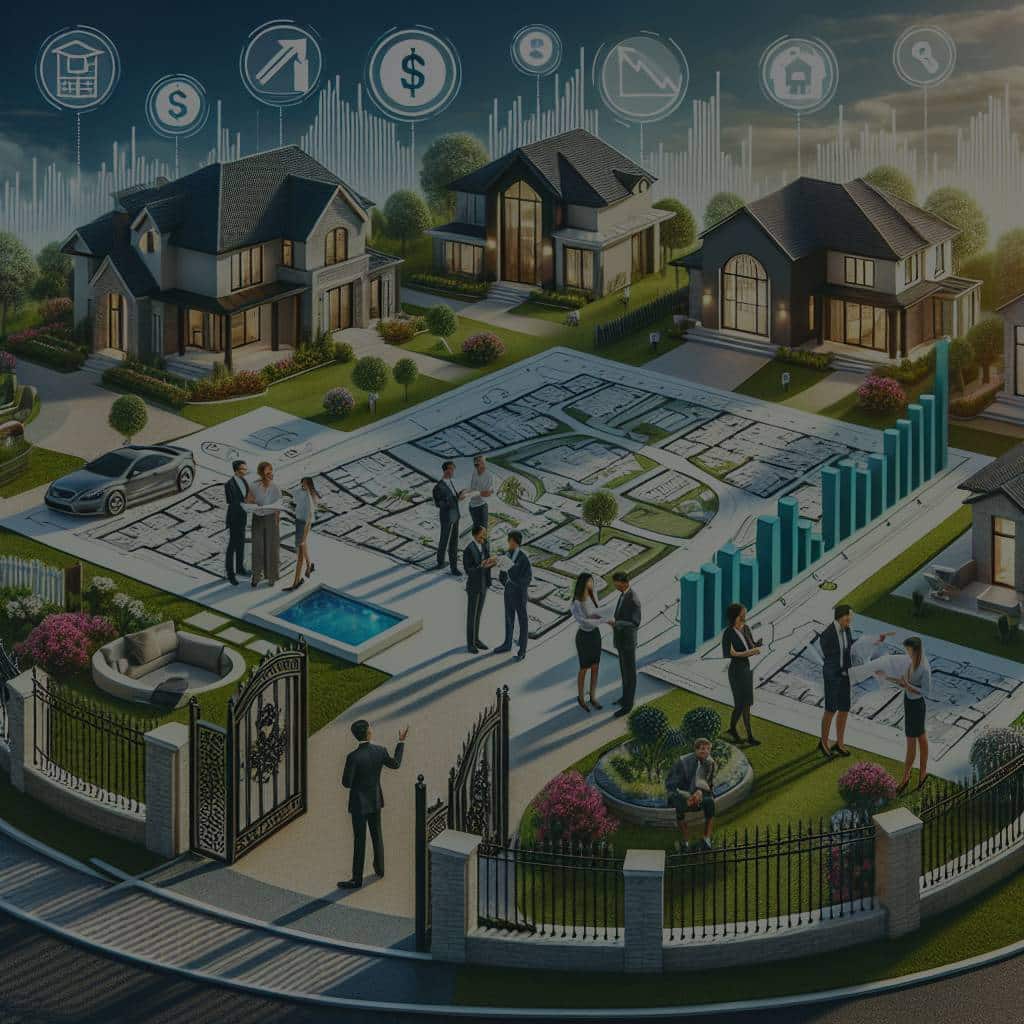What Are the Key Success Factors for Real Estate Developments in Gated Communities?

As you ponder upon the trajectory of real estate trends, it’s hard to overlook the rising popularity of gated communities. These collective housing spaces are increasingly becoming the go-to choice for many residents, and for good reasons. Nonetheless, for these gated community developments to be successful, they must meet certain criteria.
Key Features of Gated Communities
A gated community is a form of a residential community, often characterized by restricted access that uses walls or fences. These communities are designed to provide a high level of security, privacy, and amenities to residents.
A lire en complément : What Are the Considerations for Developing Real Estate in Tornado-Prone Areas?
Gated communities can vary significantly in size, from a tiny housing project of a dozen homes to a large, planned community with thousands of residences. Often, these communities are defined by their McMansions, large, modern houses that are seen as a status symbol.
Gated communities also offer a collective sense of community. This is not just about having a physical barrier that separates you from the outside world, but about the sense of belonging that comes with living in close proximity to others who share similar lifestyles and values.
Dans le meme genre : What Strategies Can Help Maximize Land Value in Real Estate Development?
Security
Security is one of the primary reasons why many individuals choose to live in gated communities. The perception, and often the reality, is that these communities are safer than non-gated communities. This is primarily because of the controlled access to the property that’s enforced through manned gates or electronic access systems.
Security personnel often monitor the entrances to these communities 24/7, providing an added layer of protection for residents. This not only discourages potential criminal activity but also provides residents with peace of mind.
Additionally, gated communities usually have strict rules and regulations that residents must abide by, further enhancing the level of security within the community.
Amenities
Another crucial factor that draws residents to gated communities is the availability of exclusive amenities. These communities often come with a wealth of amenities such as parks, swimming pools, gyms, clubhouses, golf courses, and even schools.
These amenities, usually within walking distance, provide residents with a level of convenience that is unsurpassed in other housing options. This also enhances the sense of community, as shared amenities provide a place for residents to interact and form social bonds.
Privacy
In addition to security, gated communities also offer a high level of privacy. The restricted access prevents unwanted intrusion from outsiders, and the layout of these communities often ensures that homes are spaced out, providing residents with their own private space.
This not only enhances the quality of life but also gives residents the freedom to enjoy their homes without the worry of being observed by outsiders. This sense of privacy is a major selling point for many residents and is particularly appealing to high-profile individuals.
Delivery and Package Management
In today’s world, where online shopping is becoming the norm, the ability to securely receive deliveries is crucial. Gated communities often have systems in place to ensure that residents’ packages are securely received and stored until they can be collected.
This might involve a dedicated delivery area, a secure package room, or even a concierge service. This not only provides convenience for residents but also adds an additional layer of security, minimizing the risk of package theft.
In summary, the key success factors for real estate developments in gated communities revolve around providing a high level of security, privacy, and amenities, coupled with efficient delivery and package management systems. Meeting these criteria can contribute to a thriving gated community that offers residents a high quality of life and a sense of belonging.
Collective Action and Social Ecological Dynamics in Gated Communities
Continuing the discussion on gated communities, it’s crucial to understand the concept of collective action and the social ecological dynamics at play. A gated community is not merely a collection of homes; instead, it operates as a microcosm of a larger society with its own institutional and social dynamics.
The success of a gated community hinges on the residents’ ability to act collectively for the common good. For instance, maintaining the community’s cleanliness, ensuring adherence to security protocols, and participating actively in managing the shared amenities. This kind of collective action, where all residents understand their roles and responsibilities in the community, significantly contributes to its success.
A strong sense of community within these gated spaces encourages residents to volunteer their time and resources for shared goals. This could range from organizing community events to helping enforce community rules. Collective action also fosters a stronger connection amongst neighbors, reinforcing the kinship that sets gated communities apart.
In terms of social ecological dynamics, gated communities provide a unique intersection between real estate development and social factors. The physical environment, including the homes, amenities, and security systems, directly influences the community’s social dynamics. For example, the availability of shared amenities like parks and pools create opportunities for socialization, fostering tighter community bonds.
Conversely, the community’s social dynamics can influence the physical environment. For instance, communities with a high degree of social cohesion may be more likely to collectively invest in improvements or enhancements to the community’s shared spaces. It’s a reciprocal relationship that enhances the overall quality of life within these communities.
Impact on Property Values and Drawbacks of Living in Gated Communities
While gated communities offer numerous benefits, they also come with certain drawbacks. Let’s explore how living in a gated community impacts property values and some potential pitfalls of this lifestyle.
In terms of property values, homes within gated communities tend to hold their value better than their counterparts in non-gated areas. This is attributed to the added security, privacy, and amenities that these communities offer, making them a desirable choice for many. As such, real estate developments in these areas are often seen as a sound investment.
However, living in a gated community isn’t without its drawbacks. One significant disadvantage is that these communities often come with higher homeowners association (HOA) fees to cover the cost of maintaining the amenities, security, and overall upkeep of the community. This added financial burden may deter some potential buyers.
Furthermore, the sense of isolation from the "outside world" can be a negative aspect for some residents. Despite the security and privacy benefits, some individuals may feel restricted by the closed gates and strict rules.
In conclusion, real estate developments in gated communities can be enormously successful, provided they fulfill key success factors such as high-level security, privacy, exclusive amenities, and efficient package management systems. However, developers must also consider the social dynamics and the potential drawbacks, including the impact on property values and the potential for isolation. By striking a balance between these factors, developers can create thriving communities that offer a unique lifestyle and a valuable investment for residents.
